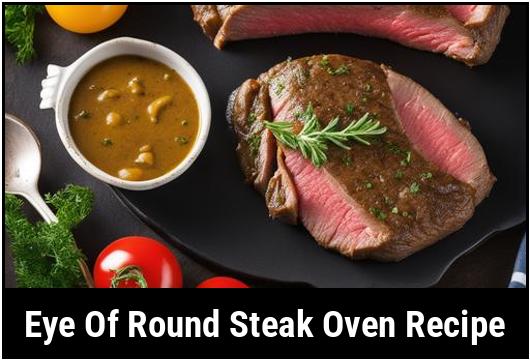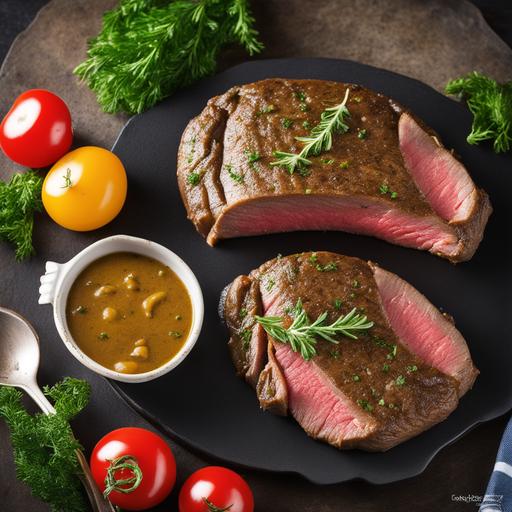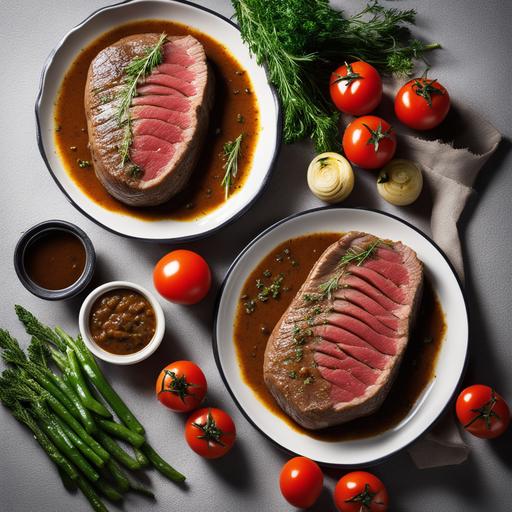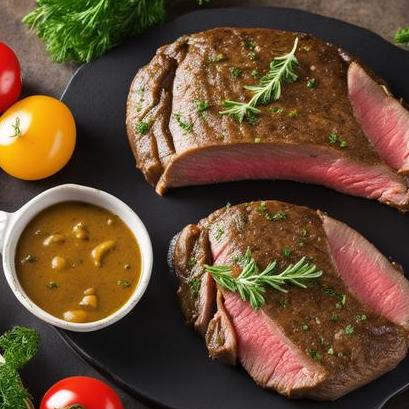
Eye Of Round Steak: A Delightful Oven Recipe
When it comes to juicy and succulent steak, the eye of round cut is a hidden gem that often goes unnoticed. The eye of round steak, sourced from the lean hindquarters of the beef, is not only budget-friendly but also incredibly versatile. In this comprehensive guide, we will delve into the depths of eye of round steak oven recipes, sharing food science, culinary details, selection, cleaning, preparation tips, variations, doneness checks, cooking techniques, and everything in between. Prepare yourself for a mouthwatering adventure!
Understanding the Food Science behind Eye of Round Steak
To fully appreciate the magic of cooking an eye of round steak, it’s essential to grasp a few food science principles. This knowledge will empower you to create a perfectly cooked steak that is tender, flavorful, and bursting with deliciousness.
The Science of Marbling and Tenderness
The eye of round steak, derived from a well-exercised muscle in the beef, is inherently tougher compared to more tender cuts. One aspect that contributes to tenderness is marbling—the intramuscular streaks of fat found in some cuts of beef. However, the eye of round has significantly less marbling, making it inherently leaner and tougher.
Breaking Down the Connective Tissue
The key to unlocking the tenderness of an eye of round steak lies within its connective tissue. Collagen, a protein abundant in connective tissue, is initially tough and chewy. However, when collagen is exposed to low and slow cooking methods, such as oven cooking, it gradually transforms into gelatin. Gelatin is not only meltingly tender but also imparts a rich and luscious mouthfeel.
Selection and Cleaning of Eye of Round Steak
To ensure a scrumptious outcome, it is crucial to choose the right cut and properly clean the eye of round steak. Follow these steps to select and clean your cut:
Selecting the Ideal Eye of Round Steak
When perusing the meat aisle, keep an eye out for a fresh and well-aged eye of round steak. Look for the following characteristics:
-
Appearance: Choose a steak with a vibrant red color and minimal browning or discoloration. Avoid any cuts with a grayish hue, as it indicates poor quality.
-
Texture: For optimal tenderness, opt for a steak with a fine texture and a smooth, slightly glossy surface. Avoid any cuts that appear overly fibrous or discolored.
-
Thickness: Aim for a steak that is at least 1 to 1.5 inches thick, as thinner cuts tend to cook quickly and may become dry.
Cleaning the Eye of Round Steak
Before diving into the culinary preparations, it’s essential to clean the steak correctly. Follow these steps to clean your eye of round steak:
-
Unpackaging: Remove the steak from its packaging and discard any excess liquid. Pat the steak dry using paper towels to remove any moisture.
-
Trimming: Inspect the steak for any excess fat or silver skin. Trim away any visible fat, as it can become chewy during cooking.
-
Optional: Tenderizing: If desired, consider tenderizing the steak using a meat mallet or tenderizing tool. This process can break down the muscle fibers, further enhancing tenderness.
Preparing the Eye of Round Steak for Oven Cooking

Now that your eye of round steak is cleaned and trimmed, it’s time to prepare it for the oven. Follow these steps to ensure the steak is perfectly seasoned and ready for a culinary masterpiece:
Seasoning the Eye of Round Steak
Seasoning plays a crucial role in elevating the flavor profile of your eye of round steak. While you can customize the seasonings to your preference, a classic combination includes:
-
2 teaspoons of kosher salt
-
1 teaspoon of freshly ground black pepper
-
1 teaspoon of garlic powder
-
1 teaspoon of paprika
Evenly rub the seasoning blend into both sides of the steak, ensuring complete coverage. Allow the steak to rest at room temperature for approximately 30 minutes to allow the flavors to penetrate.
Enhancing Flavor with a Marinade (Optional)
For an extra burst of flavor, consider marinating your eye of round steak. While marinating is optional, it can tenderize the muscle fibers and infuse the steak with delicious aromatics. Prepare a marinade of your choice using ingredients such as:
-
Olive oil
-
Balsamic vinegar
-
Worcestershire sauce
-
Soy sauce
-
Fresh herbs (e.g., rosemary, thyme)
-
Garlic cloves
Combine the marinade ingredients and submerge the steak in a Ziploc bag or a glass dish. Allow the steak to marinate in the refrigerator for at least 2 hours or overnight for maximum flavor infusion.
Cooking Techniques: Oven Preparation

Cooking eye of round steak to perfection requires a gentle and slow oven preparation method. Let’s explore the different techniques and variations you can employ to achieve delightful results.
Basic Oven Cooking
The basic oven cooking technique ensures even heat distribution, helping to break down collagen and achieve tender results. Follow these steps for a straightforward oven-cooked eye of round steak:
-
Preheating the Oven: Preheat your oven to 325°F (165°C) to provide a controlled, low-temperature cooking environment.
-
Oven-Safe Pan: Place an oven-safe pan or skillet on the stovetop over medium-high heat. Add a small amount of oil (e.g., vegetable oil) to the pan to promote browning.
-
Searing the Steak: Once the pan is heated, carefully place the seasoned and marinated steak in the pan. Sear for 2-3 minutes per side, or until a beautiful golden-brown crust forms.
-
Oven Placement: Transfer the pan with the seared steak directly into the preheated oven. Allow the steak to continue cooking for approximately 10-12 minutes per pound, or until the internal temperature reaches your desired doneness.
-
Resting and Carving: Once cooked to perfection, remove the steak from the oven and let it rest for 5-10 minutes on a cutting board. Carve against the grain into thin slices and serve immediately.
Variations: Sous Vide Method
For the more adventurous home cooks, the sous vide technique presents an exciting and foolproof alternative. Sous vide involves vacuum-sealing your steak in a plastic bag and immersing it in a precisely controlled water bath. This low and slow cooking process yields extraordinary results, ensuring maximum juiciness and tenderness. If you wish to explore sous vide cooking for your eye of round steak, follow these additional steps:
-
Sous Vide Setup: Acquire a sous vide machine or immersion circulator to maintain a precise water temperature. Set the water bath to 130°F (54°C) for medium-rare or 140°F (60°C) for medium doneness.
-
Sealing in Flavor: Prior to immersing the steak in the water bath, ensure it is placed in a vacuum-sealed bag or a sturdy freezer bag with the air pressed out.
-
Sous Vide Cooking Time: Submerge the sealed steak fully into the water bath and cook it for at least 2-3 hours, allowing the meat to reach the desired internal temperature slowly.
-
Finish with a Sear: After the sous vide process, remove the steak from the bag and pat it dry. Sear the steak in a hot pan or on the grill for 1-2 minutes per side to achieve a delectable crust.
-
Carving and Serving: Allow the steak to rest before slicing thinly against the grain. Each tantalizing slice is now ready to be savored.
Determining Doneness and Avoiding Under/Overcooking

Properly gauging the doneness of your eye of round steak is tantamount to a satisfying culinary experience. Overcooking can result in dry and tough meat, while undercooking can compromise both taste and food safety. Follow these guidelines to achieve your desired level of doneness:
Doneness Indicators
-
Internal Temperature: Invest in a reliable instant-read meat thermometer to accurately measure the internal temperature. For rare steak, aim for 120-125°F (49-52°C). Medium-rare should fall between 130-135°F (54-57°C), while medium reaches 140-145°F (60-63°C).
-
Visual Examination: By making a small cut or incision, you can inspect the color and texture of the cooked steak’s interior. Comparing the visual appearance to a doneness chart will help you gauge the desired level.
-
Finger Test: If you wish to forego the use of a thermometer, the finger test can provide a rough indication of doneness. Gently press the center of the steak with your thumb and compare the firmness against different regions of your hand.
Avoiding Undercooking or Overcooking
Achieving the perfect doneness requires precision. While overcooking can be discouraging, undercooking can hinder both flavor and food safety. Here are a few tips to avoid these pitfalls:
-
Using a Meat Thermometer: Invest in an instant-read meat thermometer for accurate temperature readings. This will prevent undercooking and allow you to achieve the desired level of doneness.
-
Resting Period: Remember that the steak continues to cook even after being removed from the oven. Letting the steak rest for a few minutes allows the residual heat to distribute evenly, ensuring optimal doneness.
-
Trial and Error: Practice and refine your cooking technique. As each oven varies in temperature and steak thickness can differ, keep records of cooking times and results to establish a personalized cooking preference.
Eye of Round Steak Recipe: Delightfully Delectable

Now that we have extensively covered the food science, preparation, and cooking techniques, it’s time to showcase a mouthwatering eye of round steak recipe that perfectly captures the essence of this cut. Prepare to excite your taste buds with flavors that will leave you craving more.
Ingredients:
-
2 pounds eye of round steak
-
2 teaspoons kosher salt
-
1 teaspoon freshly ground black pepper
-
1 teaspoon garlic powder
-
1 teaspoon paprika
-
2 tablespoons olive oil
Instructions:
-
Preheat your oven to 325°F (165°C) and position the oven rack in the middle.
-
In a small bowl, combine the kosher salt, black pepper, garlic powder, and paprika.
-
Rub the seasoning blend evenly over both sides of the eye of round steak, allowing it to rest at room temperature for 30 minutes.
-
Heat a tablespoon of olive oil in an oven-safe pan or skillet over medium-high heat.
-
Carefully place the seasoned steak into the pan and sear for 2-3 minutes on each side until a beautiful golden-brown crust forms.
-
Transfer the pan with the seared steak directly into the preheated oven.
-
Cook the steak for approximately 10-12 minutes per pound or until the internal temperature reaches your desired doneness.
-
Remove the steak from the oven and let it rest on a cutting board for 5-10 minutes.
-
After resting, thinly slice the steak against the grain.
-
Drizzle the remaining tablespoon of olive oil over the sliced steak for added richness and flavor.
-
Serve the delicious eye of round steak with your favorite side dishes and enjoy!
Explore the Versatility of Eye of Round Steak
While the above recipe offers a delightful starting point, don’t hesitate to experiment and explore the vast array of flavors that can complement eye of round steak. Here are a few variations and ideas to kick-start your culinary creativity:
-
Asian-inspired Marinade: Marinate the steak in a mixture of soy sauce, ginger, sesame oil, and honey for a fusion of bold flavors.
-
Herb-infused Delight: Make an herb-based marinade or create a herb crust using rosemary, thyme, and minced garlic, enhancing the aroma and taste of the steak.
-
Spicy Explosion: Incorporate various spices like cayenne pepper, chili powder, or smoked paprika into your seasoning mix for an extra kick.
-
Beef Roulade: Roll the eye of round steak after marinating it with your choice of ingredients, such as spinach, cheese, and sun-dried tomatoes. Secure with toothpicks and cook to perfection!
Final Words: Master the Art of Eye of Round Steak Oven Perfection
Congratulations! You have now elevated your culinary prowess by diving into the depths of eye of round steak oven recipes. Armed with food science knowledge, selection tips, cleaning techniques, and a delightful recipe, go forth and conquer the kitchen with confidence. Don’t forget to experiment, adapt, and enjoy the process of mastering the art of eye of round steak perfection. Happy cooking!
Note: Remember, cooking times and temperatures may vary based on your specific oven and steak thickness. Always prioritize food safety and adjust cooking times accordingly.
Sources
FAQS On Eye Of Round Steak Oven Recipe
What Is Eye Of Round Steak?
Eye of round steak is a lean and affordable cut of beef that comes from the round primal cut. It is a tougher cut that requires proper cooking techniques to make it tender and flavorful.
How Do You Cook Eye Of Round Steak In The Oven?
To cook eye of round steak in the oven, preheat the oven to 375°F. Season the steak with salt, pepper, and any other desired seasonings. Place the steak on a baking sheet or in a roasting pan and bake for 25-30 minutes or until the internal temperature reaches 135°F for medium-rare. Let the steak rest for a few minutes before slicing and serving.
How Do You Make Eye Of Round Steak Tender?
Eye of round steak can be tough if not cooked properly. To make it tender, consider marinating the steak for 4-6 hours or overnight in a mixture of oil, acidic ingredients like vinegar or citrus juice, and spices. You can also use a meat tenderizer to break down the tough fibers.
What Side Dishes Go Well With Eye Of Round Steak?
Since eye of round steak is a lean and simple cut of meat, it pairs well with bold and flavorful side dishes. Some great options include roasted vegetables, mashed or roasted potatoes, creamy polenta, or a fresh salad.
Can You Use A Meat Thermometer To Check The Doneness Of The Steak?
Yes, a meat thermometer is the most accurate way to check the internal temperature of the steak and ensure that it is cooked to the desired level of doneness. For medium-rare, the internal temperature should read 135°F, while medium should be 145°F and well-done should be 160°F.


